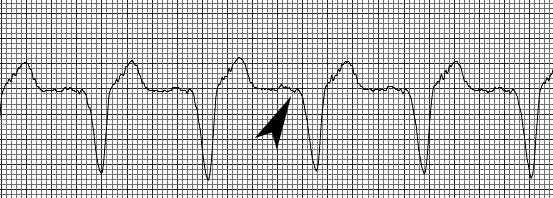Description
Patients with a variety of rhythm abnormalities have implantable pacemakers to either provide a backup pacemaker should the heart’s conduction system not work properly, or to provide a constant pacemaker function if part of the heart’s conduction system has failed permanently. Typical conditions that may require a pacemaker are failure of the SA node, second degree block, high degree or third degree block, or as a corrective measure when various surgical interventions have caused disruptions in the heart’s conduction system.
Pacemaker rhythms are generally distinguished by a widened QRS complex, .180 seconds in the example above. A normal QRS complex is .04-1.0 seconds. In addition, the actual pacemaker impulses may be seen, although they tend to be very small. In the example above, a very tiny impulse can be seen before each QRS complex (the arrow is pointing to one of them). A further discussion of pacemakers in not attempted here, as there are many different types of pacemakers, and many different modes in which they can operate.

